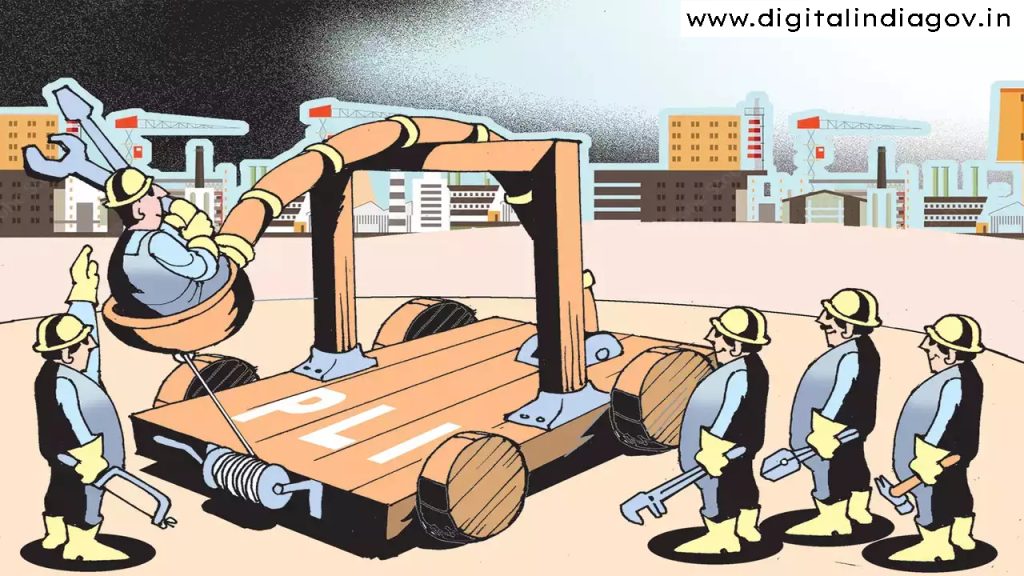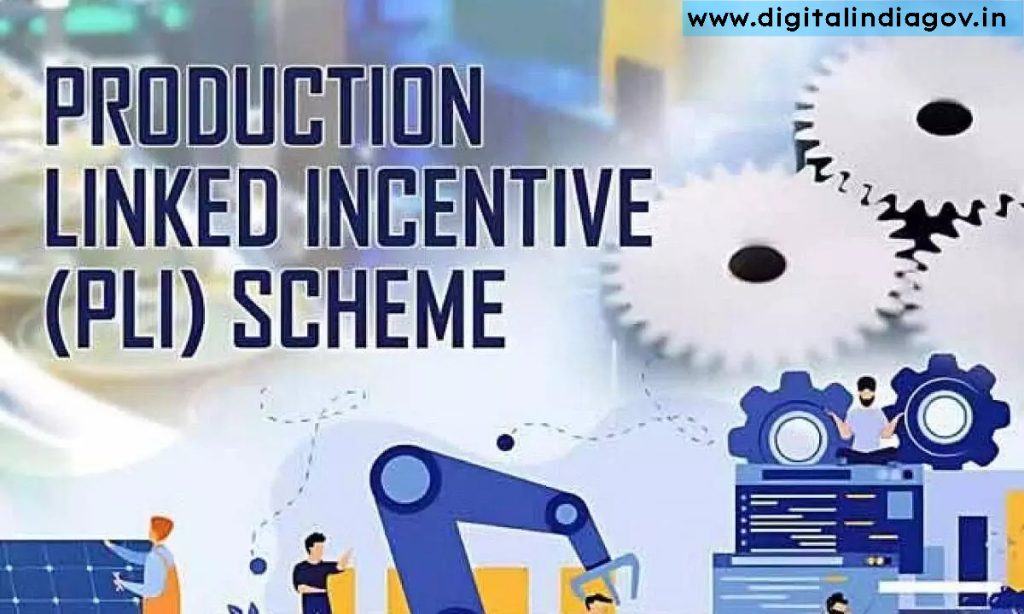PLI Scheme:- In an effort to increase exports, investments, and domestic manufacturing of networking and telecom products, the Department of Telecommunications (DoT) announced the launch of the “Production Linked Incentive (PLI) Scheme” on February 24, 2021. The PLI Scheme has a five-year implementation period and a budget of ₹ 12,195 Crores (Rupees Twelve Thousand One Hundred and Ninety-Five Crore exclusively). The PLI scheme has designated the Small Industries Development Bank of India (SIDBI) as its Project Management Agency (PMA). The program will go into effect on April 1, 2021. Successful applicants may invest in India between April 1, 2021, and the end of the Financial Year (FY) 2024–2025, subject to meeting specific incremental annual thresholds. The support provided by the Scheme will run for a total of five years, from FY 2021–2022 to FY 2025–2026.
Also Read:- PMEGP Scheme
Contents
PLI Scheme – A Brief Background
- The IT Ministry introduced it as a part of the National Policy on Electronics to provide incentives ranging from 4 to 6% to electronic companies that produce electronic components such as transistors, diodes, and mobile phones.
- The principal objective of this initiative was to attract overseas investors to set up production plants in India while also motivating indigenous manufacturers to expand and generate employment opportunities.
- The PLI scheme began targeting the large-scale electronics manufacturing sector in April 2020. In April 2020, the PLI scheme started focusing on the large-scale electronics manufacturing industry. With the large-scale electronics manufacturing industry in mind, the PLI program was developed and is scheduled to launch in April 2020. The PLI program covered ten more industries by November 2020, including food processing, telecom, electronics, textiles, specialty steel, automobiles and auto components, solar photovoltaic modules, and white goods like LEDs and air conditioners.
- The program is open to any electronic manufacturing company based in India or recognized internationally that has its registered office in India.
- In the Union Budget 2021, Finance Minister Nirmala Sitharaman announced a five-year plan that would include thirteen more sectors. Starting in the Financial Year 2022, Rs. This scheme will receive an allocation of 1.97 lakh crores.

Expansion of Production Linked Incentive Scheme
On November 11, 2020, the Union Cabinet, presided over by Prime Minister Narendra Modi, approved the launch of the PLI scheme for the ten important industries that can boost exports and strengthen India’s manufacturing capabilities.
Ten schemes have been expanded, they are listed below along with the authorized financial outlay:
| Sectors | Implementing Ministry/Department | Approved financial outlay over a five-year period (Rs. in crores) |
| Advance Chemistry Cell Battery | NITI Aayog and Department of Heavy Industries | 18100 |
| Electronic/Technology Products | Ministry of Electronics and Information Technology | 5000 |
| Automobiles & Auto Components | Department of Heavy Industries | 57042 |
| Pharmaceuticals drugs | Department of Pharmaceuticals | 15000 |
| Telecom & Networking Products | Department of Telecom | 12195 |
| Textile Products: MMF segment and technical textiles | Ministry of Textiles | 10683 |
| Food Products | Ministry of Food Processing Industries | 10900 |
| High-Efficiency Solar PV Modules | Ministry of New and Renewable Energy | 4500 |
| White Goods (ACs & LED) | Department for Promotion of Industry and Internal Trade | 6238 |
| Speciality Steel | Ministry of Steel | 6322 |
The government wants to accomplish the following goals, which are based on the ten sectors to which the Production Linked Incentive scheme was extended:
- India is expected to have a US$1 trillion digital economy by 2025 as a result of the government’s projects like Smart Cities and Digital India,
- The PLI scheme will increase the competitiveness of the Indian automotive industry and facilitate the globalization of the Indian automotive sector.
- The country’s textile industry is the largest in the world, and the scheme is expected to attract significant investment in the sector to boost domestic manufacturing, especially the man-made fiber segment and technical textiles.
- In a similar vein, the introduction of telecom, solar energy, pharmaceuticals, white goods, and all the other sectors can boost the nation’s economy and establish India as a global center for manufacturing.

Benefits of PLI:
A government-run initiative called the Production Linked Incentive (PLI) scheme provides manufacturers with financial incentives to boost output. The program was introduced as a part of the Made in India campaign in March 2020.
The PLI scheme offers the following benefits:
- promotes homegrown manufacturing
- increases rivalry
- generates job opportunities
- Brings in investment
- lessens reliance on imports Provides incentives to qualified businesses based on increased sales over a five-year period
Also Read:- Janani Suraksha Yojana
In 2021, the PLI program was revealed for 14 sectors, which included:
- Large-scale production of electronics
- White goods
- Cloths
- medical equipment
- Vehicles
- unique steel
- food items
- solar PV modules with high-efficiency
- Modern chemistry cell batteries
- UAVs
- Medications
Who Is Eligible for the Performance Linked Incentive Scheme?
People should be aware that different sectors may have different eligibility requirements. For example, the PLI scheme for the automotive industry may differ slightly from the electronics industry scheme.
It would be helpful to check the official website in this regard. However, the following are the general prerequisites for eligibility.
- The sale of manufactured goods and the threshold of cumulative incremental investments determine a telecom unit’s eligibility.
- Fifty percent of the stock in subsidiaries in the food processing industry must be owned by SMEs and other businesses.
- A company’s net worth in the pharmaceutical manufacturing industry shouldn’t be less than 30% of the total investment. This project ought to be classified as a greenfield project.
- The Domestic Value Addition, or DVA, for products derived from fermentation must be at least 90%.
- DVA for products derived from chemical synthesis ought to be close to 70%.
- Examining the advantages that the Production Linked Incentive scheme sectors stand to gain.
Challenges Faced by the PLI Scheme
- Only two or three of the 14 eligible sectors were expected to meet their PLI scheme first-year targets, according to a report.
- Companies that have received or are anticipated to receive incentives under the scheme cannot be evaluated using a standard set of criteria to determine their value addition.
- The industries believe that more incentives are needed to make India more attractive than China and Vietnam, based on the research.
- For the companies to properly manage the program and increase exports, more incentives are required.
- The nation does not have a centralized database to track advancements. NITI Aayog plans state that an external entity, either Sidbi or the state-owned IFCI Ltd., will design and prepare the database.
How to Apply for a PLI Scheme?
People should be aware that various industries have distinct application processes. This is an illustration of how to create an application for the telecom industry.
- Step 1: Go to the official website of the Production Linked Incentive scheme.
- Step 2: Select “Register” from the homepage.
- Step 3: Complete the registration form for a large-scale electronics company under the Production Linked Incentive Scheme, providing information like the organization name, address, and PAN.
- Step 4: Click “Register” to finish your application.
- Here are some essential details about the PLI scheme and how it works. To learn more about the specifics of the incentives, people should regularly check out the official website.
They would be able to learn the most recent PLI terms and schemes through this practice.
Also Read:- Odisha Labour Card 2023

What are the Documents Required Against the PLI Scheme?
An individual must submit the following documents online when completing the application.
- Certificate of Company Registration
- Association Memorandum (print copy)
- Candidate’s CIN
- A copy of the association’s articles
- PAN information
- xerox GSTN Certificate
- The profile of the company
- Specifics about the experience and profile of top management
- Letter of Authorization
- FY 2020–21 interim annual account
- Agreement on Consortium (IFA Annexure -5)
- IFA Board Resolutions, Annexure 4Net worth certificate authorized by a statutory auditor
- The project’s construction plan and PERT chart
- Licenses, clearances, and permissions from third parties
- Duration for obtaining pending clearances
- Annual reports from FY 2019–2020 to FY 2017–18
- The details of creating jobs (semi-skilled, unskilled, and skilled)
- Cover letter using IFA Annexure-1 as a guide
- Drawing from a power of attorney, IFA Annexure-2
- Benefits details according to IFA Annexure-6
- pledging to avoid any outstanding debts and legal disputes
- In addition to the aforementioned documents, the applicant needs to verify the information provided in the electronic form. They must upload the appropriate papers.
FAQ’s
Q. What is the PLI Scheme
- Ans- About
- The PLI program was designed to increase employment and import substitution while also increasing domestic manufacturing capacity.
- A further allocation of Rs 19,500 crore was made towards PLI for solar PV modules in Budget 2022–2023 in addition to the Rs 1.97 lakh crore the government has set aside under the PLI schemes for various sectors.
- When the program was first introduced in March 2020, it focused on three industries:
- Transportable and related Component Production
- Manufacturing of Electrical Components and
- Medical Equipment
Q. What is the Plan?
- The NITI Aayog intends to take the lead in establishing a centralized database to track advancements in PLI schemes throughout various sectors. To design and prepare the database, the agency will contract with state-owned IFCI Ltd. or SIDBI.
- This database will include information on value addition, actual exports in comparison to committed exports, and employment creation.
Conclusion
India’s GDP is predicted by the World Bank to increase by 8.7% in 2022–2023. The growth is significantly higher than that of other emerging competitors during the same period, including Bangladesh (6.4%), Indonesia (5.2%), and China (5.1%). The initiative is predicted to boost India’s GDP by 1.7% and generate $150 billion in new sales by 2027. A key factor directing the country’s development into “Atmanirbhar Bharat” is manufacturing. Over the past few years, the sector’s share of the GDP has fluctuated between 17% and 20%. Nonetheless, a number of “Atmanirbhar Bharat”-related projects are establishing the framework for enhancing the nation’s manufacturing capabilities and increasing the industry’s GDP share. The pandemic’s effects on global supply chains opened the door for later reforms, which led to the introduction of programs like the Production Linked Incentive (PLI) scheme to lessen reliance on trade.
Suggested Link:-Mobile Number Tracker Online
@PAY
